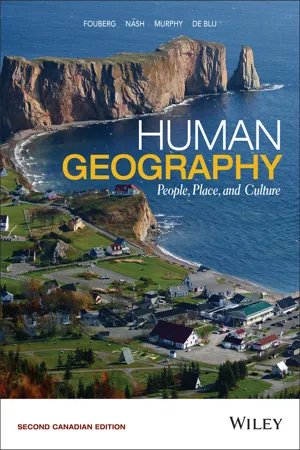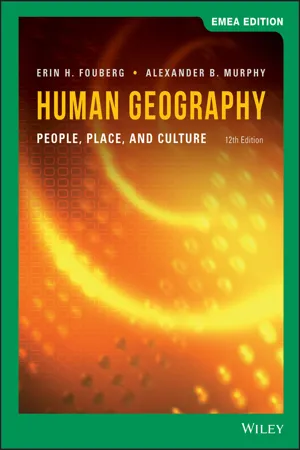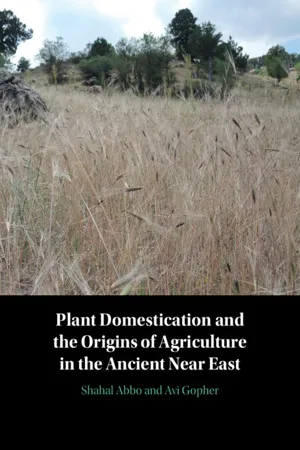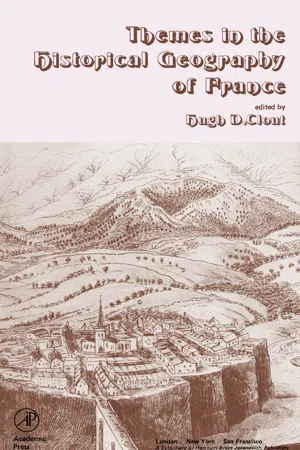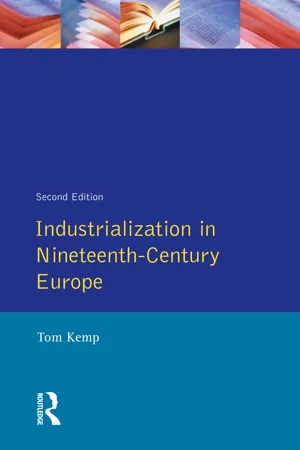Geography
Second Agricultural Revolution
The Second Agricultural Revolution, which took place from the late 17th century to the late 19th century, was characterized by significant advancements in farming techniques and technology. This period saw the widespread use of new tools, such as the seed drill and iron plow, as well as the adoption of crop rotation and selective breeding. These innovations led to increased agricultural productivity and laid the foundation for modern industrial agriculture.
Written by Perlego with AI-assistance
Related key terms
1 of 5
5 Key excerpts on "Second Agricultural Revolution"
- eBook - PDF
Human Geography
People, Place, and Culture
- Erin H. Fouberg, Alexander B. Nash, Alexander B. Murphy, Harm J. de Blij(Authors)
- 2015(Publication Date)
- Wiley(Publisher)
This phase in the evolution of agriculture involved the intro- duction of new crops, the expansion of farm sizes, innova- tions in farm machinery, and improvements in methods of soil preparation, fertilization, crop care, and harvesting. • The Third Agricultural Revolution, of which the Green Revolution has been a part, dates as far back as the 1930s. Over time, this phase has been marked by drastic increases in agricultural production that stemmed from the creation of new seed varieties; the use of fertilizers, pesticides, and irrigation in some places; and significant capital improvements. • The geographical impact of the Green Revolution has been highly variable. While countries such as Mexico and India have experienced large increases in productivity, Africa has thus far seen only a limited impact. • One controversial element of the Third Agricultural Revolution has been the creation of genetically modified or- ganisms, which prompted fears about food quality and safety. Moreover, small-scale farmers often have not bene- fited because they lack the resources to acquire genetically enhanced seeds and the necessary fertilizers and pesticides. MAIN POINTS 9.2 How Did Agriculture Change with Industrialization? - eBook - PDF
Human Geography
People, Place, and Culture
- Erin H. Fouberg, Alexander B. Murphy(Authors)
- 2020(Publication Date)
- Wiley(Publisher)
In the 1700s and 1800s, European farmers bred dairy cattle to adapt to different climates and topography. For example, the black-and-white Holstein dairy cow came from the Netherlands and is well suited to graze on With shifting cultivation, farmers avoid monoculture, which is more taxing on the soil and makes it more difficult for a community to build a nutrient-rich diet. Instead, farmers plant a diversity of crops, both for self-consumption and for trade in local markets (Fig. 11.8). In northern Thailand, hill tribes such as the Hmong, Lisu, Yao, Khamu, and Karen plant rice, sticky rice, maize, beans, gourds, eggplants, sugarcane, taro, yams, sesame, and chili peppers (see Fig. 11.1). In Africa, shifting cultivators plant yams, cassava, bananas, oil palm, maize, and other crops. In the Amazon in South America, shifting cultivators plant trees such as acai palms and avo- cado trees, as well as crops such as cassava, plantains, maize, and sweet potatoes. The Second Agricultural Revolution: Mechanization of Agriculture To fuel the industrialization and urbanization that occurred from the 1700s on, people needed to create a Second Agri- cultural Revolution, moving beyond subsistence farming to generating the surpluses needed to feed thousands of peo- ple working in factories instead of on agricultural fields. Like the Industrial Revolution (see Chapter 12), the Second Agricultural Revolution included a series of innovations, improvements, and techniques developed in different places at different times, which together significantly improved the production of crops and livestock. In the 1700s, the British and the Dutch invented the seed drill, improved livestock breeding methods, consolidated land into larger farms, and began using new crop rotation sys- tems. The seed drill enabled farmers to avoid wasting seeds and to plant in rows, making it simpler to distinguish weeds FIGURE 11.8 Mopti, Mali. - Shahal Abbo, Avi Gopher, Gila Kahila Bar-Gal(Authors)
- 2022(Publication Date)
- Cambridge University Press(Publisher)
1 WHAT IS THE AGRICULTURAL REVOLUTION? The Agricultural Revolution (which made us all – humans – food-producers) is a major landmark in human history. It reflects a significant transformation in the general organiza- tion of human society and its components (see Glossary, General Terms, Agricultural Revolution). Since the advent of humans as tool-makers, some three million years ago, that is, since the moment we began producing tools and using them as a key vehicle in our daily activities, no transformation was as significant as the Agricultural Revolution. After three million years of living in small, mobile communities while subsisting by hunting animals and gathering plant foods, the Agricultural Revolution, which took place post-Pleistocene, during the Neolithic period, just over 10,000 years ago, brought about a prominent transformation in human life-ways. Mostly, it allowed humans to become food-producers, rendering them a unique and singular being on Earth. Small or large sedentary farming villages, characterizing the new way of life in the Near East, soon grew in size to very large villages, also known in Neolithic research as towns, 1 which later became cities (Figure 1.1). Some claim that the development of cities in the Near East about 6,000–5,000 years ago, compared to the large villages that preceded them, was but a natural development of phenomena that had originated in the Agricultural Revolution. Others see a major significance in this transformation of urbanization. In their view, and we concur, this was another revolution that bore additional extensive consequences for the socio- economic fabric.- eBook - PDF
- Hugh D. Clout(Author)
- 2013(Publication Date)
- Academic Press(Publisher)
11 AGRICULTURAL CHANGE 427 The outworking of earlier changes that was captured in 1840 derived from modification in farming practice that had been diffused almost exclusively from Flanders, England and Switzer-land. Very little, it is claimed, had come from Mediterranean Europe. Morineau, ( 1970b) believes 'there is nothing in the 1840 statistics to suggest an agricultural revolution' (p. 180). The Flemish borderland along the Belgian frontier emerges as the only really progressive area and when information for the département of the Nord is disaggregated it becomes clear that not only were there important internal contrasts, with some localities being quite backward, but also that the root crops, complicated rotations, intensive stock-rearing and heavy fertilization that characterized agriculture intensification had their origins much earlier than the eighteenth century ( Fig. 11.11 ) . 7 FIG. 11.11. Aspects of agriculture in the Nord département c. 1800 ( by canton ) : (a) leading aspect of land use, by proportion of land covered; (b) leading cereal crop, in terms of land covered; (c) proportion of land under artificial grasses; (d) livestock combinations in ranked order. 428 HUGH D. CLOUT Morineau's work is stimulating in three main respects. First, it questions conventional wisdom about the definition and very exist-ence of an agricultural revolution. Important though indicators of change may be, Morineau insists that it is only the net results— summarized in terms of productivity per unit area—that are significant. Past emphasis on the scientific principles and practical experiments of agronomists, the publication of learned articles by agricultural societies, and even the cultivation of new crops has been misleading since each of these themes involved only the land-owning elite, and a small proportion of that, rather than the peasant masses. - eBook - ePub
- Tom Kemp(Author)
- 2014(Publication Date)
- Routledge(Publisher)
Chapter Two Agrarian revolution and industrializationBefore industrialization society was made up predominantly of people who obtained their living from tilling the soil and raising animals; that part specialized in other pursuits depended for its support upon the surplus extracted by one means or another from the direct producers. The period immediately preceding industrialization in Europe, the ‘pre-industrial’ period, saw important changes in the agrarian structure, in an uneven way, but suggesting that changes of a certain kind and in a certain direction were necessary pre-conditions for it. In a summary way it can be claimed that traditional agriculture, carried on mainly by the peasantry, producing for household use and local consumption, had to be superseded by a more commercialized agriculture, producing partly for the market, if favourable conditions for industrialization were to come into being. This process was not only uneven between regions but it was spread over a long period of time, including that in which industrialization was going on, and, in a sense, where the peasantry survives, has still not been wholly completed.For centuries before industrialization began there is a history of settled agricultural communities in most parts of Europe. Although in many places new land was still being brought into cultivation this was small in extent compared with the area on which a setded agrarian life had been going on for a thousand years or more. Many traits of European agriculture, resulting from an adaptation of man to prevailing conditions of the soil and the climate in the earliest times, had a pretty well continuous existence through this time. For instance, this was an area of dry farming which did not require extensive irrigation works and which was based on a combination of cereal cultivation with animal husbandry. It thus lent itself to the establishement of selfcontained rural communities which produced enough to support a ruling class of landowning warriors. In the period after the decline of the Roman Empire there developed the peculiarly European variety of feudalism consisting of the imposition of manorial organization on the groundplan of the village community of an earlier period of tribal settlement. In turn, European feudalism displayed many local variations and began to change as a result of many different factors with unequal local weights.
Index pages curate the most relevant extracts from our library of academic textbooks. They’ve been created using an in-house natural language model (NLM), each adding context and meaning to key research topics.
